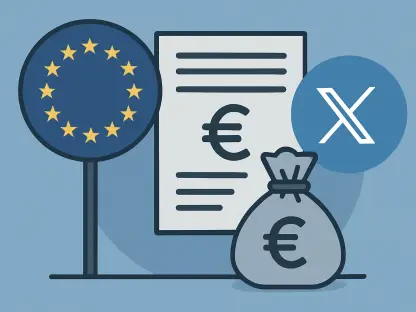In a digital era where smartphones have become an extension of daily life, the UK mobile app market has achieved a staggering valuation of £28.3 billion in 2025, cementing its status as a powerhouse within the national economy. This remarkable milestone reflects not just the ubiquity of mobile technology but also the profound ways in which apps have reshaped how people communicate, entertain themselves, and conduct business across the country. From bustling city centers to quiet rural towns, mobile applications are no longer mere conveniences—they are essential tools driving productivity, leisure, and commerce. This surge is fueled by near-universal smartphone ownership, skyrocketing app downloads, and a cultural shift that prioritizes digital interaction over traditional media. As technology continues to evolve with innovations like artificial intelligence and ultra-fast networks, the industry stands on the brink of even greater expansion. What forces are propelling this unprecedented growth, and how are they transforming the landscape for consumers, developers, and businesses alike? This exploration delves into the economic impact, user behaviors, platform rivalries, and cutting-edge trends defining this dynamic sector.
Economic Might of Mobile Apps
The valuation of £28.3 billion in 2025 positions the UK mobile app market as a critical driver of economic activity, with forecasts estimating a rise to $36.29 billion by 2030 at an impressive compound annual growth rate of 15.1%. This sector contributes approximately 1.5% to the UK’s GDP, a testament to its significance beyond mere numbers. It also sustains around 400,000 jobs, spanning development, marketing, and support roles, thereby anchoring a substantial portion of the workforce. Consumer spending on apps has seen a dramatic doubling since 2017, despite economic headwinds, placing the UK as the fifth-largest global market for app expenditure. This financial clout underscores how deeply mobile technology has integrated into the fabric of modern life, influencing everything from small startups to multinational corporations.
Beyond its direct contributions, the mobile app industry catalyzes growth in adjacent sectors such as e-commerce, gaming, and digital services. Businesses across the spectrum are investing heavily in digital transformation, recognizing apps as vital channels for customer engagement and operational efficiency. Advanced development frameworks have further accelerated this trend by streamlining the creation of sophisticated applications, reducing time-to-market for innovative solutions. As companies leverage these tools to meet consumer demand, the ripple effects are felt throughout the economy, fostering an environment where digital innovation is not just encouraged but expected. The sustained growth trajectory suggests that this sector will remain a cornerstone of economic progress for years to come.
Smartphone Ubiquity and User Reach
Smartphone penetration in the UK has reached near-saturation levels, with 95% of the population—equating to roughly 53 million individuals—owning a device as of early 2025, a notable increase from 90% just two years prior. This rapid adoption, which contrasts sharply with a mere 17% ownership in 2008, illustrates the profound integration of mobile technology into everyday routines. Ownership rates are particularly striking among younger demographics, with 98-99% of those aged 16 to 54 possessing a smartphone, while even among seniors over 65, adoption stands at a robust 82%. Such widespread access highlights the democratization of digital tools across age groups and social strata.
Supporting this pervasive adoption is a robust network infrastructure that ensures connectivity for the vast majority of users. Currently, 58% of Brits have access to 5G networks, while 93% are covered by either 4G or 5G, facilitating seamless app usage even in remote areas. The total number of mobile connections, at 88.4 million, surpasses the population, indicating a trend of multiple device ownership per person. This extensive reach not only amplifies the potential user base for app developers but also creates fertile ground for continuous innovation in mobile services. As connectivity improves and devices become more accessible, the foundation for further market expansion strengthens, ensuring that mobile apps remain central to societal functions.
Surge in App Downloads and Engagement
The UK is on track to exceed 8.5 billion app downloads in 2025, a dramatic leap from 1.8 billion recorded in 2021, reflecting an insatiable appetite for mobile software. This surge parallels a significant rise in revenue, climbing from £2.46 billion to £3.97 billion over a similar timeframe, demonstrating both the volume and value of digital engagement. Gaming applications lead the charge in generating income, but other categories like e-commerce, entertainment, and financial technology also command substantial download figures, catering to diverse consumer needs. This broad appeal underscores the versatility of apps as tools for both leisure and necessity.
Daily interaction with mobile devices further illustrates this cultural shift, as screen time averages between 4 and 5 hours, surpassing traditional television viewing, which stands at 3 hours and 16 minutes. Messaging and social networking apps dominate, accounting for 49% of mobile usage, while audio streaming and video content follow with 20% and 15%, respectively. Regional disparities are evident, with urban hubs like Liverpool and Leicester reporting higher engagement compared to areas like Bristol. This data points to a fundamental change in how media is consumed, with mobile apps emerging as the primary conduit for information and entertainment, reshaping societal habits in profound ways.
User Demographics and Behavioral Patterns
Diving into the demographics of app usage reveals distinct patterns across age groups, with younger users aged 18 to 24 leading as the most active segment, spending nearly 5 hours daily on their devices. This group often interacts with their phones within moments of waking, showcasing a deep reliance on mobile technology for social connection and information. Usage of social networking apps is particularly high among this demographic, with 81% engaging regularly, though this figure drops sharply to just 15% among those over 65, indicating a generational divide in digital priorities. Despite these differences, certain activities, such as taking photos, maintain popularity across all age brackets, reflecting universal appeal.
Gender also influences app engagement, with women dedicating more time to social platforms, averaging 2 hours and 47 minutes daily, compared to men at 2 hours and 34 minutes. This variance suggests differing preferences in content consumption and interaction styles, with social media serving as a key outlet for communication among female users. Such insights into behavioral trends are crucial for developers aiming to tailor applications to specific audiences, ensuring relevance and usability. As these patterns evolve, they paint a complex picture of a market driven by diverse needs and habits, challenging the industry to adapt continuously to user expectations.
Competitive Landscape of Platforms and Devices
The UK mobile operating system arena presents a near-even split, with Android holding a slight edge at 50.07% and iOS close behind at 49.44% as of 2025. However, beneath this balance lies a stark demographic divide: 69% of users aged 16 to 24 gravitate toward iOS, drawn by its premium branding and ecosystem, while Android captures 55% of those over 65, often due to its affordability and variety of devices. Socioeconomic factors and gender also play roles, with higher-income groups and women showing a preference for iOS, while cost-conscious users lean toward Android, with 53% spending under £400 on their devices compared to just 17% of iPhone owners.
In the device market, Apple commands a 49.44% share, followed by Samsung at 32.41%, creating a duopoly that leaves minimal space for competitors like Google and Motorola, which hold under 5% each. App store economics further highlight iOS’s dominance in revenue, with Apple users spending 2.4 times more per person than those on Google Play, despite the latter accounting for 70% of downloads. This disparity reflects differing monetization strategies, with subscriptions driving 85% of App Store revenue versus 72% on Google Play. Such dynamics shape developer priorities, influencing where resources are allocated in a fiercely competitive digital marketplace.
Network Dominance and Technological Frontiers
In the realm of mobile networks, EE stands as the undisputed leader with a 31% market share, outranking competitors like O2 at 22% and Vodafone at 21%. Its consistent recognition as the top-performing network, evidenced by winning the UK Overall RootScore Award for the 24th consecutive time in 2025, reinforces its position. A significant shift looms on the horizon with the planned merger of Vodafone and Three in early 2025, which could consolidate the major operators from four to three, potentially altering pricing structures and service quality. Such changes might ripple through to app developers and users, impacting data costs and connectivity reliability.
Technological advancements are equally transformative, with artificial intelligence enabling hyper-personalized app experiences, such as tailored financial advice or predictive shopping suggestions. Cross-platform development tools like Flutter and React Native cut costs by 40-70%, allowing seamless app deployment across Android and iOS. Privacy-first designs, mandated by GDPR compliance, address rising data security concerns, while 5G’s expansion—with speeds 100 times faster than 4G—alongside integration with wearables and IoT devices, redefines app functionality. These innovations collectively push the boundaries of what mobile applications can achieve, setting a new standard for user interaction and developer efficiency.
Shaping the Future of Digital Interaction
Reflecting on the trajectory of the UK mobile app market, the £28.3 billion valuation achieved in 2025 marked a pivotal moment, highlighting the sector’s integral role in both economic and social spheres. High smartphone penetration at 95%, coupled with 8.5 billion app downloads, underscored the pervasive influence of mobile technology. Demographic nuances, from youth-driven iOS adoption to gender-based usage patterns, painted a diverse user landscape, while network leaders like EE and tech giants like Apple shaped the infrastructure supporting this digital boom. Innovations in AI, 5G, and privacy design signaled a relentless push toward enhanced functionality.
Looking ahead, stakeholders must prioritize strategies that harness these technological advancements while addressing challenges like data protection and market competition. Developers should focus on creating adaptive, user-centric applications that leverage AI and cross-platform tools to meet evolving demands. Businesses, meanwhile, can capitalize on this growth by integrating mobile solutions into their core operations, ensuring they remain agile in a digital-first world. Policymakers might consider frameworks that balance innovation with consumer safeguards, fostering an environment where the projected growth to $36.29 billion by 2030 can be realized sustainably. These steps will ensure the continued ascent of this vibrant industry, shaping how society interacts with technology in the years to come.









